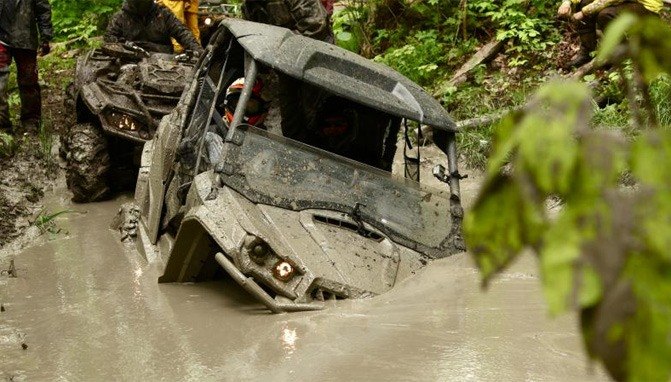How To Fix a Flood-Damaged UTV
From time to time you will see someone dip their UTV a little extra deep into the watery abyss. This is not exactly a death sentence, provided that machine is properly snorkeled, but what if you encounter a flood that holds your SXS under water for a few days? What do you do now? If you have insurance, most would simply call the insurer and post a claim for the sunken machine. However, if you do not have adequate coverage, or lack any coverage at all, where do you begin with a flood-damaged UTV?
There are a few steps that need to happen as soon as possible as well as things that need to be looked at with a sharp eye. The main thing to remember is to NOT attempt to start the machine. It will be tempting to turn the engine over and try to start the rig, but that needs to be put off for a moment until you do a thorough check of everything mechanical. Provided they weren’t affected already when the battery shorted out, electrical accessories and sensors can be damaged permanently simply by turning the switch to the on position after a flood. Just don’t do it.
After a flood situation, where you know there is potential for problems, you should strip and clean your rig thoroughly to get a clearer picture of any damage.
Engine
So, let’s say you have suffered the unfortunate event of a flood or maybe a good long term sinking of your UTV where the water is over any venting or snorkel intake or exhaust. The very first thing a UTV owner needs to do is to drain all of the fluids in the machine except for maybe the coolant, as it is sealed away from the environment. The coolant is worth checking, but it’s far from the most critical area of concern. The oil and driveline fluids are most susceptible to water intake due to the many vents and holes leading into the engine as well as the driveline. Milky oil is a clear sign that there could be even more inspections needed.
After removing the Valve cover as well as one camshaft for a closer inspection it was clear that we needed to go further due to the murky oil in the area.
Once the fluids have been drained, an old mechanic’s trick is to fill the engine and differentials with diesel fuel and allow them to soak in for a few minutes. This should help push any other watery fluids out of higher areas that tend to hold oil even when the drain plug is out. Diesel fuel has oil in it, so it acts like a lubricant while flushing the system. When draining the diesel, pay close attention to the condition of the fluid as it drains and this will let you know if you need to repeat the process. It needs to be clear of any signs of a milky condition. You can then refill and move on to other items.
If the machine has sat underwater for a few days or has not been started since its flooding, then you really need to look into the cylinder for potential issues. Rings and ring lands on the piston can rust quickly and seize in place. This not only causes the potential for ring breakage, but it can damage the cylinder walls simply by rusting pits into the cylinder. Cylinders with even the slightest pitting can catch rings and snap them into tiny pieces, sending the damage even further into the motor.
As mentioned, the oil in the case of this engine has had some water intrusion. Notice the rings on the piston as well as the piston ring lands or grooves as they too are rusty.
CVT Transmission
Belt drive transmissions have exhaust and intake venting, so there will be water in the CVT housing if the machine has been sunken over these factory snorkels. Some CVT housings have small plugs in the lowest point of the front cover and can be drained easily from there. The primary and secondary clutch should be inspected as well if the machine has sat under water for a long period of time. The clutch sheaves or position where the belt rides can corrode and create pitting which could kill a belt under a heavy use situation. It’s always best to remove the cover once drained and closely inspect the clutching. Water can find its way deep into the clutch and any rust will inhibit the operation of the clutching, which could also further damage the CVT system.
Electrical
Wiring is tricky and requires plenty of patience especially when it has been subjected to plenty of water.
Electrical is what gets the UTV owner more than anything else in a flood situation. Contrary to popular belief, not all electrical components in UTVs are sealed, potted (covered in a waterproof substance) or enclosed to be waterproof. I know, kind of crazy, right? We ride in many different environments, so why isn’t my machine ready for any of them? Some components are not even water tight and others might be, but short circuits caused when the ignition is switched on can instantly ruin them. Batteries obviously still have a charge when the water starts to rise, and overloading circuits is a real possibility.
The next issue with wiring is corrosion. Again, not all wire is created equal and corrosion or high load creates high resistance and then leads to voltage shortfalls, which make some electrical components act up and many will not operate at all. Does this mean that a flooded UTV is a lost cause? That is a great question and one that is kind of hard to answer. Some Side-by-Side owners may never have one single electrical issue after a flood, but others may have gremlins for the remainder of the machine’s life.
The combination of the LOADPro test tool and a good multimeter make finding short circuits, open circuits and high resistance wiring simple and fast when dealing with flooded electronics.
The process of inspecting and testing components can be arduous and taxing on one’s patience, but with the proper tools it can be done. Using a smart tool like the LOADPro test leads with an ordinary electrical meter can help you locate high resistance circuits, shorts and open circuits quickly and easily. This plug and play tool allows you to “Load” the circuit with 12 volts and find those pesky high resistance gremlins quickly. Visual inspection is always another choice and looking for blown fuses or component circuitry that is acting erratic is a great place to start.
So, What Now?
Is a flooded UTV a lost cause? Not entirely would be my answer. Should you use caution when buying a flooded machine? The short answer is yes but be open minded to the way it was handled after the flooding. It is never a lost cause, but knowing how deep you are willing to go to nurse the rig back to health is the real elephant in the room.
We are committed to finding, researching, and recommending the best products. We earn commissions from purchases you make using the retail links in our product reviews. Learn more about how this works.
Whether he is in Mexico covering the Baja 1000, building ATVs for local racers, or out enjoying the trails, Rick’s passion shows in his stories. Learning to wrench his own machines from his grandfather, Rick also has an undying appreciation for the mechanics of off-road vehicles. Do not let the dirt and mud fool you, though, as Rick also has a deep love for street cars.
More by Rick Sosebee

















![Pedal Powered Side-by-Side [video]](https://cdn-fastly.atv.com/media/2022/10/24/8744132/pedal-powered-side-by-side-video.jpg?size=350x220)














